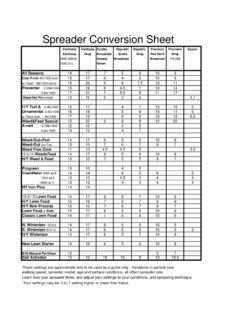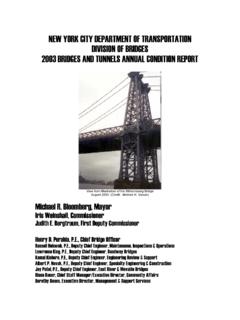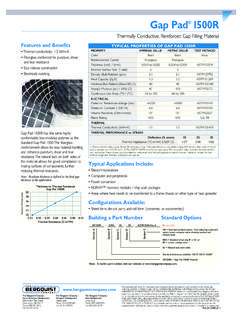Transcription of 15 Hints and advice - Sails
1 Hints and adviceon rigging and tuning of your Seld n mastHints and advice 15 Instructions for rigging. Conditions for valid types4 Longitudinal rigging6 Lateral rigging8 Running rigging10 Preparing the yacht for rigging13 Checking the mast14At the crane20 Keel-stepped masts22 Alternative rigging of jib furling system26 Tensioning the cap shrouds28 The folding rule method 29 Tuning for safety30 Masthead rigs32 Fractional rigs4219/20 rig and similar48 Bergstr m-Ridder rig50 Booms53 Rodkicker56 Working aloft57 Unstepping the mast60 Winter maintenance61 Damage or cosmetic flaws?65 Storage66 Mounting new fittings67 Masts which are seldom unstepped68 Boat ashore with the rig still in place68 Calculating mast and rig dimensions69 Positive roach + in-mast furling72 Sail slides and sail entry (MDS)73 The Seld n product range74 Notes80 Conversion factors81 All rights reserved. No portion of this publication may be reproduced without the written permission of Seld n Mast in Sweden.
2 Specifications and instructions contained herein are subject to change without notification. Seld n Mast ABThe rig a combination of masts, booms, rigging and alltypes of equipment. It is obvious that the rig is a large andvital part of your yacht. Tuning for the best mix of perfor-mance, reliability and operating safely requires a degreeof knowledge. With Hints and advice , we aim to sharewith you our practical experience. You probably know mostof this, but there is always something new to first part of the book describes stepping masts andpreparations in general. It is absolutely essentialthat youread this information, no matter what type of rig you have. After you have done that, please follow the rigginginstruction appropriate to your rig type. This is, of course,important from a safety point of view, but it is also acondition of our will also give you an insight into how our rigs should behandled in practice, and the best way for you to look afteryour rig to ensure that it performs well for many you read Hints and advice , you might come acrosssome unfamiliar technical terms.
3 Nautical language isfamous for using words which are unfamiliar to manypeople. We suggest you have our product catalogue to handalongside Hints and advice , as it has an alphabeticalindex and illustrations of most of the components of a hope you ll find Hints and advice useful. Fair winds, The Seld n Group23 The rigBear in mind that, as the yacht s Owner, you are responsiblefor any accidents or damage resulting from negligence or poorhandling. Seld n s Hints and advice is an educational aid,but ultimately, the safety of vessel and crew depend on the careand judgement exercised by the yacht s types4 Masthead rigFractional rigDeck-steppedmastKeel-steppedmastIn-li ne spreadersSweptspreadersSingle ormultiple-spreaderrigs7 Fractional rig6 Masthead rigLongitudinal riggingForestayRunners CheckstayCutter stayForestayBaby stayInner forestayBackstayRunnersCheckstayBackstay Backstay:Stays the top of the mast against movement for-wards.
4 The backstay tension is adjusted using some form oftensioning device to control mast-bend and forestay tension. Forestay:Sail-carrying stay for the genoa and jib. Preventsthe top of the mast moving aft. The tension of the forestayisaffected by the backstay, cap shrouds (on rigs with sweptspreaders), runners and the sheeting of the stay:Sail-carrying inner stay for jib or staysail. On a masthead rig, if it can be attached within 6% of thefore-triangle height below the forestay fitting, it can be tensioned by the backstay. If it is attached lower down, runners or possibly forward-angled jumpers must be used. Inner forestay:Attached about 60% of the fore-triangleheight above the deck. This stay does not carry a sail, but isintended only to stay the mid-section of the mast fore-and-aft, in conjunction with stay:Attached in the region of the lower stay is not sail-carrying, but is intended to stay thelower panel of the mast fore-and-aft, in conjunction withaft lower shrouds.
5 Runners:Also known as running backstays . On a mast-head rig, runners interact with a cutter stay. They are morecommonly found on fractional rigs, where they are used totension the forestay. Runners consist of two wires attachedto the sides of the mast. The runnersare adjusted using tack-les at their lower ends. The windward runner is always undertension. The leeward runner is always slack, otherwise itwould interfere with the mainsail and boom. Runners fittedclose to the yacht s midships line only affect the fore-and-aftstaying of a mast with in-line spreaders. If they are fitted to the yacht s quarters they also affect the lateral rigging. Checkstays:Function in principle as runners, but areattached lower down the mast. They are intended to stabilisethe mid-section of the mast to prevent uncontrolled mast-bend and pumping. Checkstays normally interact with theinner forestay. Triatic stay:Forestay for a mizzen mast.
6 Attached betweenthe masthead fittings. On smaller yachts, the stay is ledthrough a block at the mizzen mast top down to the deck,where the length can be adjusted. Cap shrouds:(V1-V3, D4) Stay the mast against lateral (athwartship) loads. Attached near the mastheadon a masthead rig, and at forestay level on a fractionalrig. The cap shrouds are led via spreaders to the boat schain stay ( jumper ):Permanent arrangement forstaying a long mast top on a fractionally rigged shrouds:(D2-D3) Fitted on multiple-spreader rigs, and attached in the area of the upperspreaders. Fitted with links in the lower spreader tips(linked rig) or pass over the spreader tips and continuedown to the deck (continuous rig). The intermediateshrouds stay the upper spreader area against movementathwartships. Lower shrouds:Attached in the area of the lowerspreaders. Stay the spreader-area athwartships. Often fitted as forward lowers (D1F) and aft lowers (D1A),which also stabilise the mast fore-and-aft, as well asdetermining mast-bend.
7 9V1D1FD1AV2D2V3D3D48 Lateral riggingJumper arrangementThis type of arrangement isdesigned for fractionally riggedyachts. The jumper struts arenormally angled forward. Thejumper arrangement stays thetop mast, not only athwartshipsbut also fore-and-aft. The use ofjumper struts enables the topmast to be given a more slendertaper. A jumper arrangementmight be necessary when usinga masthead gennaker/spinnakeror for stabilising the top of = Diagonals V = VerticalsContinuous riggingHalyards:Rope or a combination of rope/wire for hoistingsails. Seld n normally colour-codes the halyards as follows: Genoa halyard: Blue Main halyard: White Spinnaker halyard: RedPrevent over-tensioning of the genoa halyardThe forestay must be properly tensioned each time thesail is hoisted. You should therefore tension the backstayand any running backstays beforetensioning the luff. Ifthe sail is hoisted firmly before the forestay is tensioned,this may put excess strain on the halyard, halyard swivel(if a jib furling system is used) and :Tackle for sheeting the mainsail.
8 Attached tothe end of the boom (end-sheeting) or further forward onthe boom (centre-sheeting). The lower part of the main-sheet is usually fitted to a car which runs on the mainsheettrack. The car s position on the track depends on how youwant to trim the sail. Genoa/jib sheet:Line for sheeting the foresail. Led viafairleads/deck blocks to sheet winches. The location of thedeck blocks can usually be altered fore-and-aft, dependingon how you want to trim the sail. Preventer guy:Used to prevent accidental gybes. Attachedto the outer end of the boom, and led forward to a cleat orled via a snatch block on the foredeck, then aft to the cock-pit. The preventer guy must not be fitted to the centre ofthe boom since that could cause damage, especially if theend of the boom goes into the water as a result of rolling. Outhaul:Used to adjust the foot of the mainsail. 1011 Main halyardGenoa halyardTopping liftCunninghamVangGenoa/jib sheetSpinnaker halyardReef 2 Reef 1 OuthaulMainsheetPreventer guyWhen connected, tension the bowline.
9 Secure it to a bow cleat, or acockpit cleat via a turning facilitate the use of a preventerguy, a rope strop can be fitted per-manently between the end fittingof the boom and the kicker the strop to the end fitting. Theforward end has a spliced eye anda guardrail type lashing. Whennot in use, the lashing is tensionedto take up the slack. Topping lift:Used to prevent the boom end dropping into thecockpit when not supported by the sail, for example while reefing. Vang (Kicking strap):Prevents the boom end from lifting when sailing downwind. Flattens the sail, and reduces twist. Oftencombined with Seld n Rodkicker, which takes over the functionof the topping lift. lines:Used to reef the Seld n s Single-Line booms, both theleach and the luff are reefed by pullingone line. Seld ncolour-codes the reefinglines as follows: Reef 1: Blue line. Reef 2: Red line. Cunningham:Line for tensioning the luff of the mainsail.
10 Preparing the yacht for riggingThe following points should be taken care of before moving the yachtto the crane Take out all the tools you will need during rigging. Make sure all rigging screws are cleaned and lubricatedwith rigging screw oil. Rigging screws with the upper thread swaged onto thewire (stud rigging screws) are threaded for extension bytwisting the body clockwise. Fit this type of riggingscrews to the standing rigging. Fit all other rigging screws to the yacht s chain plateswith the left-hand thread downwards. Extend the riggingscrews to the maximum extension by twisting the bodyclockwise. Ensure that the clevis pin at the upper end ofthe rigging screw can be removed quickly. All riggingscrews will now operate in the same direction, and it willbe easier to attach the shrouds and stays. Fit backstay adjuster. The fork-ended rigging screw shown right may only be used if the chainplate is angled correctly and the rigging screw able to align with the stay.


